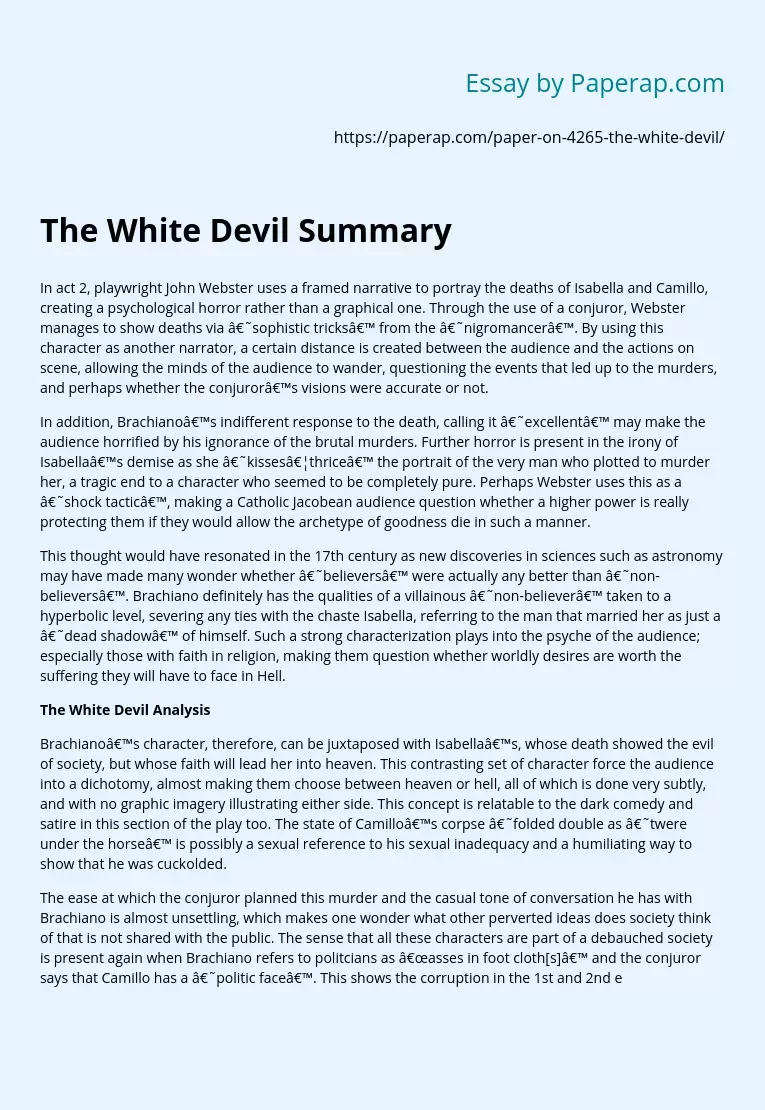In act 2, playwright John Webster uses a framed narrative to portray the deaths of Isabella and Camillo, creating a psychological horror rather than a graphical one. Through the use of a conjuror, Webster manages to show deaths via ‘sophistic tricks’ from the ‘nigromancer’. By using this character as another narrator, a certain distance is created between the audience and the actions on scene, allowing the minds of the audience to wander, questioning the events that led up to the murders, and perhaps whether the conjuror’s visions were accurate or not.
In addition, Brachiano’s indifferent response to the death, calling it ‘excellent’ may make the audience horrified by his ignorance of the brutal murders. Further horror is present in the irony of Isabella’s demise as she ‘kisses…thrice’ the portrait of the very man who plotted to murder her, a tragic end to a character who seemed to be completely pure. Perhaps Webster uses this as a ‘shock tactic’, making a Catholic Jacobean audience question whether a higher power is really protecting them if they would allow the archetype of goodness die in such a manner.
This thought would have resonated in the 17th century as new discoveries in sciences such as astronomy may have made many wonder whether ‘believers’ were actually any better than ‘non-believers’. Brachiano definitely has the qualities of a villainous ‘non-believer’ taken to a hyperbolic level, severing any ties with the chaste Isabella, referring to the man that married her as just a ‘dead shadow’ of himself.
Such a strong characterization plays into the psyche of the audience; especially those with faith in religion, making them question whether worldly desires are worth the suffering they will have to face in Hell.
Brachiano’s character, therefore, can be juxtaposed with Isabella’s, whose death showed the evil of society, but whose faith will lead her into heaven. This contrasting set of character force the audience into a dichotomy, almost making them choose between heaven or hell, all of which is done very subtly, and with no graphic imagery illustrating either side. This concept is relatable to the dark comedy and satire in this section of the play too. The state of Camillo’s corpse ‘folded double as ‘twere under the horse’ is possibly a sexual reference to his sexual inadequacy and a humiliating way to show that he was cuckolded.
The ease at which the conjuror planned this murder and the casual tone of conversation he has with Brachiano is almost unsettling, which makes one wonder what other perverted ideas does society think of that is not shared with the public. The sense that all these characters are part of a debauched society is present again when Brachiano refers to politcians as “asses in foot cloth[s]’ and the conjuror says that Camillo has a ‘politic face’. This shows the corruption in the 1st and 2nd estate, making the audience question whether these hateful figures of government have only immorality in common.
Underlying these comic dumb shows with such rhetorical questions truly makes the audience question whether it is moral to find these scenes amusing. The audiences morality is once again called into question when they desire to know more about the details of Isabella and Camillo’s death which, like Brachiano, they ‘taste not fully. ’ The audience may be facing another dilemma when they consider that such injustice in society may be happening all around them, quite horrific to know that such exaggerated scenes may be very real.
The White Devil Analysis. (2019, Dec 05). Retrieved from https://paperap.com/paper-on-4265-the-white-devil/

